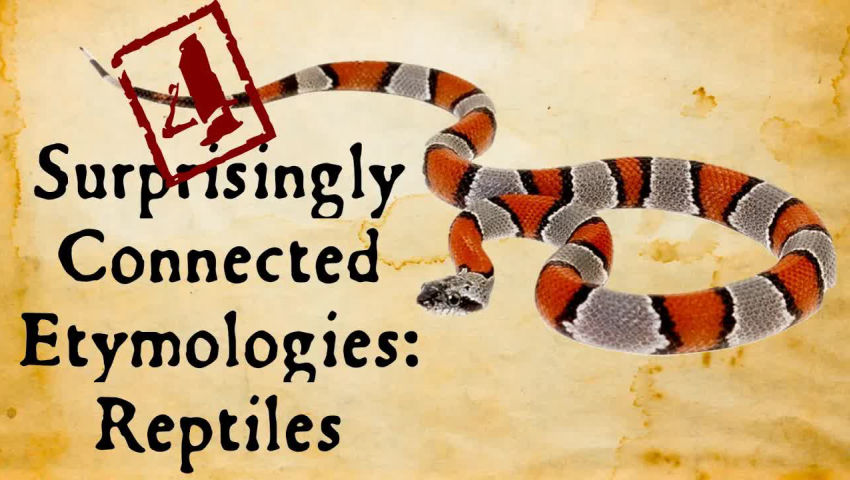 tilvids.com
tilvids.com
The origins of "Vixen". This is part of a series on Santa's reindeer. #etymology #WordNerd #linguistics #HistoricalLinguistics #language #words #lingcomm #twasthenightbeforechristmas #rudolph #santasreindeer #santa #holidays #christmas #vixen
 tilvids.com
tilvids.com
The origins of "Prancer". This is part of a series on Santa's reindeer. #etymology #WordNerd #linguistics #HistoricalLinguistics #language #words #lingcomm #twasthenightbeforechristmas #rudolph #santasreindeer #santa #holidays #christmas #Prancer
 tilvids.com
tilvids.com
Some words for reptiles and their interesting etymological connections. Thank you to all our Patreon supporters! Please check out our Patreon: https://www.patreon.com/TheEndlessKnot Endless Knot merchandise can be found in our store: https://www.redbubble.com/people/EndlessKnot/ Show notes & credits: http://www.alliterative.net/general-credits Website: http://www.alliterative.net/ Twitter: https://twitter.com/alliterative Facebook: https://www.facebook.com/alliterativeendlessknot Tumbler: http://alliterative-endlessknot.tumblr.com/ SoundCloud: https://soundcloud.com/alliterative Podcast: http://www.alliterative.net/podcast or https://itunes.apple.com/ca/podcast/endless-knot-podcast-endless/id1016322923?mt=2 Click here to sign up for our video email list, to be notified when new videos are posted: http://eepurl.com/6YuJv Click here to sign up for our podcast email list, to be notified when new podcast episodes go up: http://eepurl.com/btmBZT Transcript Today in “Surprisingly Connected Etymologies”, we’re going reptilian! Serpents don’t give you herpes, but etymologically they should. Serpent comes from Latin serpens “snake” ultimately from the Proto-Indo-European root *serp- “to crawl, creep”. This root also leads to Greek herpein “to creep” from which comes the Greek, Latin, and English word herpes referring to a “spreading” skin condition. Also related is herpetology, the scientific study of reptiles and amphibians. Reptile, by the way, comes from a similar root, PIE *rep- “to creep, slink”, from which comes Latin repere “to creep” and eventually English reptile. In terms of their biological classification, alligators and lizards aren’t the same, but etymologically they are. Lizard comes from Anglo-Norman lusard and Old French laisarde, from Latin lacertus “lizard”, which came into Spanish as lagarto. This was used in the Spanish phrase el lagato de Indias “the lizard of the Indies” to refer to the alligator, and in English this phrase became shortened to aligarto and eventually alligator, with the Spanish definite article becoming part of the word. The words basil and basilisk look a bit similar but what does a herb have to do with a mythical reptilian monster? Turns out it’s a particularly royal etymology. The etymon behind both words is Greek basileus “king”. Basil was so called because it was used in making royal perfumes, and the basilisk was so named because of the crown-like crest on its head, at least according to the Roman writer and naturalist Pliny. And finally, this one’s not a reptile, but it’s crept in anyhow. Do frogs frolic? Etymologically they should. Frog comes from Old English frogga ultimately from the PIE root *preu- “to hop”. This root also leads to Middle Dutch vro “leaping with joy”, which comes into English as frolic. And if it keeps you leaping with joy to hear, the etymology of that other focus of herpetology, namely amphibians, means literally “leading a double life” (those crafty frogs!), coming from the Greek prefix amphi- “both, on both sides” (also in the word amphitheater), ultimately from the PIE root *ambhi- “around”, plus the Greek word bios “life” (as in biology “the study of life”) from the PIE root *gwei- “to live”. Originally the words amphibian and amphibious could refer to anything “combining two completely distinct or opposite conditions or qualities”, with, for example, Joseph Addison using it in the 18th century to refer to clothing that we might now call unisex, and with the more general biological sense of any animal that lived both in water or on land, including crocodiles, beavers, and hippopotami, before it was narrowed to its more specific modern sense. Thanks for watching! This is one in a series of occasional short videos about connected etymologies; to see more, you can also follow the Endless Knot on Twitter, Facebook, or Instagram.
Alliterative
alliterative@ tilvids.comHello, my name is Mark Sundaram! I'm a university prof with a PhD in Medieval Studies. I use language, literature, and history to explore the web of connections in the world around us. Many of my videos start with a word as a jumping off point, with its history and etymology opening up a way to explore history and culture more widely. Others examine literary devices, cognitive science, myth, history of science, and other topics. The endless knot is a common visual motif of an interconnected knot with no beginning or end, found in many cultures around the world. My use of the symbol is a reference to the 14th c. poem "Sir Gawain & the Green Knight", where it describes the pentangle which Gawain has emblazoned on his shield as a symbol of the interconnectedness of things. Here it also gains significance from its comparison to the cognitive science hexagram which shows the interrelated nature of various fields in cognitive science. Be sure to visit my website at www.alliterative.net